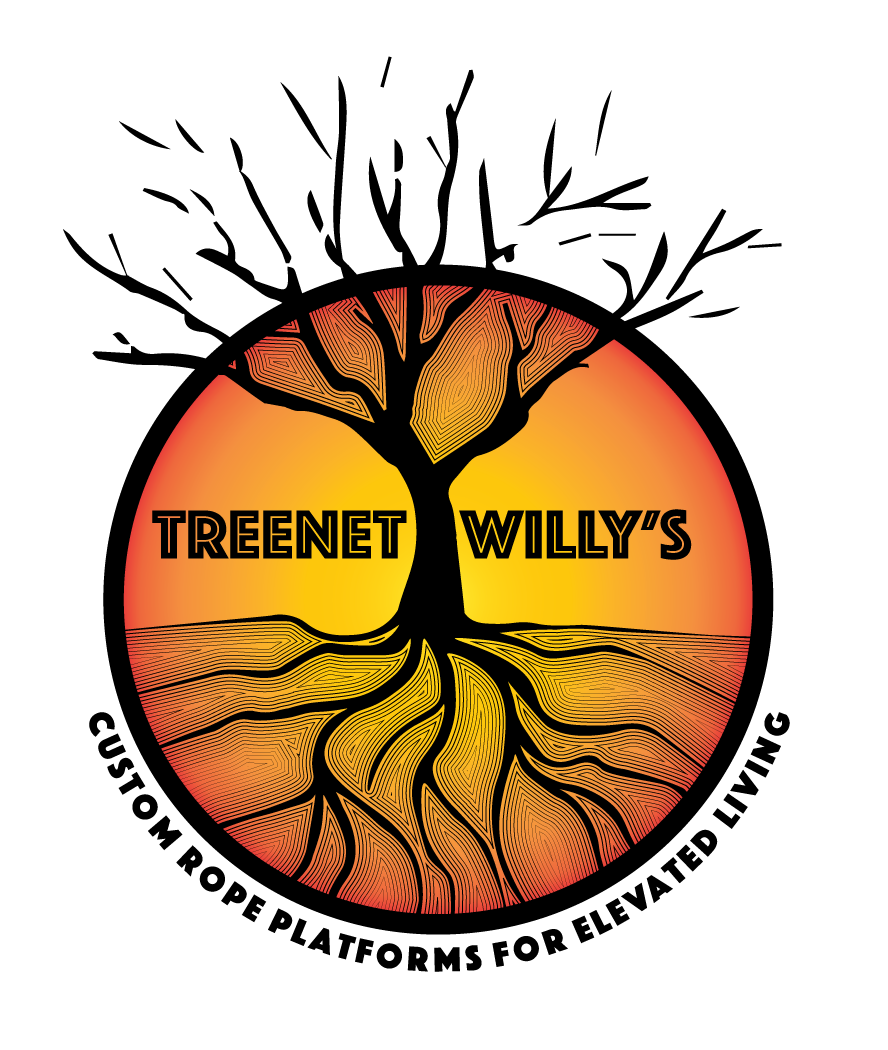our signature weaving style
Since TreeNet Willy started weaving in 2008, we’ve crafted hundreds of hand-woven tree nets worldwide, establishing our own unique weaving patterns and styles that set us apart from the competition.
History of TreeNets
The TreeNet community began in the ‘90s, with activists protesting the clear-cutting of redwoods. These protestors created tree platforms using nets instead of wood, giving rise to an innovative and eco-friendly way to live among the trees.
I learned my early weaving techniques from my cousin, Hippy Pete, who began making these nets with his friends at UC Santa Cruz in the mid-2000s. These early tree nets were camouflaged and hidden high above the ground, inspiring the chaos pattern that we continue to use today.
Below you can see Hippy Pete in a net with an original chaos pattern.
Hippy Pete, 2007
Since those early days, I’ve added my own twist to these nets, incorporating new patterns, vibrant colors, accessories, Moki ladders (explained below), and UV cord.
As our work has gained popularity worldwide, many others have taught themselves how to weave similar nets. We’ve built friendships with many of them and are thrilled to see the craft spreading, but we take pride in setting the curve with our distinctive weaving patterns and styles.
Our patterns are not just visually appealing but are also designed to ensure your nets are secure and built to last.
Our Weaving Styles
Chaos Pattern
The chaos pattern is as old as the art of weaving nets itself. While it’s not unique to the TreeNet Willy’s team, it’s one of our signatures because it’s the most organic and versatile way to fill various shapes.
What makes our chaos pattern stand out is our ability to weave custom elements like words, logos, and images directly into the design, making your tree net truly one-of-a-kind.








Yoga Pants
Our Yoga Pants pattern has become one of our most iconic patterns. We call it yoga pants because one day, a few of us were in the backyard coming up with new patterns in an effort to differentiate ourselves. I told the boys to go crazy and do whatever they want so we could find approaches that would stick.
At one point, we look at one of the patterns and realize it looked a lot like someone wearing yoga pants. The name caught on, and ever since then, we’ve made Yoga Pants our signature style.
Yoga Pants is great for almost any net because we can cover a lot of surface area and make it look uniform.
geometric Center Pieces
In 2018, I began exploring alternative ways to suspend nets without relying solely on trees. I found an old trampoline frame that became the perfect symmetrical canvas for weaving intricate geometric patterns.
By aligning various points with the legs of the trampoline, I was able to create a wide range of geometric shapes, flowers, and centerpieces that we now use in various projects.
Metal Rings and Portals
Metal rings have been a cornerstone of our designs from the start because of their incredible versatility. We use metal rings of all sizes to create portals, cup holders, swings, centerpieces, and tunnels.
In the first picture of the gallery, you can see three metal rings suspended above each other, forming a Moki tunnel that allows people to climb up to the top level.
Moki Steps
Our Moki steps are inspired by the Native Moki (Moqui) Steps found throughout the American Southwest, created by the Ancestral Puebloans. These steps, carved into sandstone, provide access to hard-to-reach areas like cliff dwellings and water sources.
After hiking in Utah and observing the Moki steps, I adapted this idea to our nets. Using a double fisherman’s loop, I can make a handhold for the knot and a space for your foot.


















































